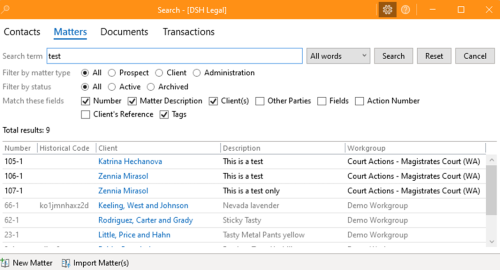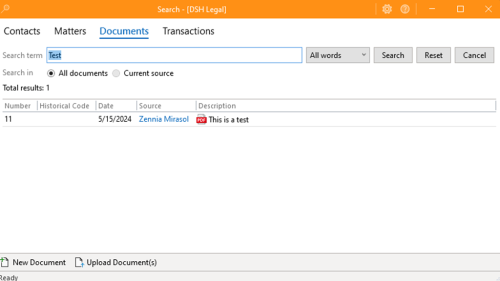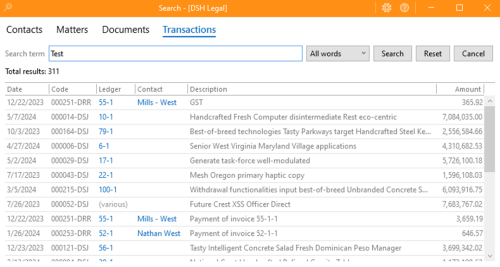Search
The ContactsLaw Search is located centrally within the application and provides quick and easy access to all information stored within the system, including contacts, files, documents and transactions. It is also the entry point for contact creation.
The search also plays an important role in locating records for the purpose of linkage. For example; when a contact must be added to a form, the user clicks the empty 'Add contact' hyperlink and is immediately taken to the search window. Upon locating (or creating) the desired contact, the search populates the empty hyperlink with a reference to the chosen contact.
The search window displays different options depending on which mode is selected.
The following modes are available:
- Contacts
- Files
- Documents
- Transactions
- Packets
- Business names and & ABNs
- Postcodes & suburbs
Contact Search
The contact search is at the center of ContactsLaw, appearing whenever details about a person or business are required in any capacity. As with other types of searches, it can be opened by the system when a contact is required for a particular field, or it can be accessed at any point in time by clicking the prominent Search button at the top of the screen.
The search window is divided into 5 major parts:
- Search term - One or more keywords that in some way describe the contact(s) you are searching for. These will be matched against a selection of fields (name, address, etc). You can determine whether to match all words in the search term, or any word.
- Search criteria - Determines which contact types to include in the search. The 3 supersets in bold will select multiple contact types.
- Advanced search - Allows you to further refine your search based on the follow advanced criteria:
- Fields - Determines which fields the keywords in the search term will be matched against. This enables you to, for example, search for all contacts on a particular street.
- Associated contacts - In the event that you know some piece of information about a contact, but are searching for another contact who may be related in some way to the first, you can select the types of relationships to traverse during the search.
- Role - You can limit the search to a particular role if you know the contact you are searching for (or one of its related contacts) appears in a particular role.
- Search results - After the search is complete, contains the contact(s) that matched the search criteria. Simple summary details are displayed, with entities being marked in bold. The results are listed in order of rank/relevance, best match first. Only the first 100 results are displayed.
- Contact creation - Following the ContactsLaw philosophy of 'search-before-you-(re)create', the contact search is the entry point into contact creation. Once the search has completed, the option to create or import a contact becomes available. Branch contacts can be created by right-clicking on an entity contact and selecting the 'create branch' option.
Search term
By default, the search will return partial and exact matches if they contain all of the words in the search term. You can change the match type to "any words" if the contact(s) you are looking for might not contain all of the words in the search term. Some words may be excluded from the search if they appear too frequently or are too short. You can enclose the term in double quotes to return only exact matches.
Similar-sounding results
Search results may contain similar-sounding results, shown in grey text. For example, if you search for "Smith" you may also get results containing "Schmidt". These results always appear at the bottom of the list.
Ranking
Results are listed in ranked in order of relevance to the search term. Factors which affect the ranking of results include:
- Whether the term partially or exactly matches the field (exact matches are ranked higher)
- The number of times the term appears in the field (repeated terms are ranked higher)
- For similar-sounding results, whether the pronounciation is the same or similar (same pronounciation is ranked higher)
- Whether the term matches the contact's middle name only (these results are ranked lower)
- Whether the result is an associated contact (associated contacts are ranked lower)
- Whether the search term was a contact/client number (the matching contact is ranked much higher)
- The number of fields containing the search term (more fields matched results in a higher rank)
Matter Search
ContactsLaw includes a sophisticated file search, which serves as the entry point for locating all active and archived matters in the system. Upon switching the Contact search to 'Files' mode, a series of search criteria will appear. You can return files where your search term matches information about the file or any of its associated contacts. As with the contact search, you can restrict/expand your search by matching 'all words' or 'any words'.
Search criteria
- Workgroup
- Company
- Member (creator/manager/supervisor)
Advanced search
- Status (active/archived/all)
- Fields (number, matter, reference, scale, workgroup fields)
- Match contacts (client, bill-to, court, parties, etc)
Defaults
By default, the file search:
- Matches all words
- Restricts the search to the active subsidiary company
- Restricts the search to active files
- Searches the file number, matter and action fields
- Includes results that match the client(s)
Document Search
The document search allows you to quickly and easily locate any document within ContactsLaw. As with the contact search, you enter a search term that is matched against the set of fields you specify; for example, the description of the document.
Search term and match type
Type your search term into the box. If you type two or more words, you can decide whether you want documents that match all words or documents that match any word in the box.
Alternatively, you can also search by contact. In this mode of operation, the search term is replaced by a field which allows you to add one or more contacts. The match type determines whether the documents matched must contain all or any of the contacts in the list.
Search criteria
- Fields
Select the fields you want to search in. The document description is the most common (and fastest) field to search in. You can search within the body of the document through integration with the Windows SharePoint Services search (results from SharePoint are combined with those matched from the ContactsLaw database). You can also type all or part of a contact's name and match documents who are associated with a particular contact, optionally selecting a role to narrow down your search.
- Document type
You can restrict the search to a specific type of document. This also determines which roles/dates you can filter by.
- Date
You can restrict the search to a specific date range, optionally using a specific document date.
- Direction
You can restrict the search to show incoming/outgoing documents.
Advanced search
Member
You can restrict the search to return documents that a particular member has been involved with, optionally selecting a particular action that occurred on the document (e.g. when the document was sent, finalised, etc).
- Workgroup
For documents on files, you can restrict the search to find only documents pertaining to a particular workgroup.
- File format
You can narrow your search to include only documents of a certain Windows file format.
- Attributes
You can further restrict the search by including only documents that match a given set of attributes.
Search results
The results of the search appear in the list below the search criteria. ContactsLaw will display up to 100 results per search. Results are ranked and ordered according to relevance, with the best match at the top of the list. You can override this order and sort by a particular column if desired; your preferences will be retained across searches, but will reset to the default order if the search is reset.
Occasionally, you may see documents in the search results which have obfuscated names and cannot be selected; these results are for documents which you have not been granted permission to view.
Transaction Search
ContactsLaw provides a transaction search, which allows you to quickly locate general/trust transactions. Your search term can match a range of transaction properties. If searching for a specific amount, you can match against the transaction total, a line total (Net+GST) or an aggregated total. A series of advanced criteria allow you to further restrict your search to a specific amount/date range, member, account type or subsidiary company.
Transaction searches always perform boolean "and" matching (i.e. "all words"), therefore a transaction will only appear in the results if it matches all of the words in your search term.
Matching amounts
The transaction search will only match exact amounts, so you must type the full figure you are searching for (dollars and cents). If the amount you are searching for is in whole dollars, you do not need to add the trailing ".00", but it is a good idea to do this to avoid matching reference/transaction/file numbers. The currency symbol ($) is optional (results will be returned whether it is present or not).
The search will also match the original amounts on cancelled cheques/receipts, as well as pending amounts on trust journals.
Matching contacts
If you expand the search to match contacts, ContactsLaw will perform a basic search against the "file as" field and then return any transactions where matching contacts appear as the payer/payee. Client names are not matched unless they appear in the aforementioned capacity.
Packet Search
ContactsLaw allows you to search for packets using a term that matches items in the packet or the packet itself. This is an alternative to the packet list accessible under The Practice.
Fields
You can search against any of the following fields:
- Name of the contact to whom the packet belongs
- Packet number
- Number or description of a document held in the packet
- Number or description of a paper file held in the packet
- Description of an arbitrary item in the packet (e.g. keys, jewellery, etc)
Options
The following options affect the search:
- Partial matching - Includes results that partially match the search term.
- Packets / items in packets - Determines whether to display one result per packet or one result per packet item.
ABR Search
The Australian Business Register (ABR) is a national register of business names, ABNs, ACNs and other publicly-available tax information. Its aim is to provide transparency and allow verification of businesses you engage in trade with. It provides forward and reverse look-up of business names and ABNs and makes it easy to determine whether there are any potential issues in relation to GST.
ContactsLaw integrates with the ABR and provides a dedicated business name search (Internet connectivity required). This search can be used at any time, but is most powerful when combined with contact creation, where it can be used to fetch details for an entity you may know very little about.
After selecting a search mode, the search term you type is sent to the ABR public web service. As the results are returned, you can elect to filter to a particular state or include less relevant (but broader matching) results.
The search returns basic/partial details for each entity (since details must be sent over the Internet), but you can drill down to discover more detail about any result.
Contact creation
When you click the 'Search ABR' button during contact creation (or if the search occurs automatically), the provisional entity name or ABN is used to pre-fill the search. Double-clicking on a search result populates the contact wizard with the details retrieved from the ABR. This may include the registered entity name, ABN/ACN, entity category and/or registered office address.
Depending on the information retrieved, you may need to complete some of the records yourself.
Postcode Search
ContactsLaw provides a postcodes & suburbs search, which allows you to quickly match a postcode to a suburb (or vice-versa). The address data used by ContactsLaw is imported periodically from a reliable source, however newer suburbs may not immediately appear in the results.
Importing address data
ContactsLaw accepts country, state and address data (to populate this search) from a range of sources. The recommended source is the Postal Address File (PAF), a document which is regularly updated by Australia Post. Address data can be imported via the Management tab on The Practice. You can choose whether to perform a full or incremental update; you should generally choose the latter option to preserve historical information, or if you have previously imported data for countries other than Australia.





